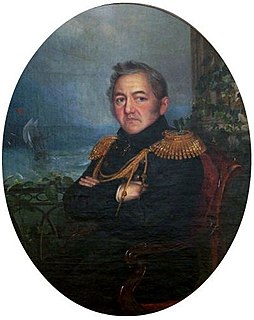
The Kirov class, Soviet designation Project 1144 Orlan, is a class of nuclear-powered guided missile cruisers of the Soviet Navy and Russian Navy, the largest and heaviest surface combatant warships in operation in the world. Among modern warships, they are second in size only to large aircraft carriers, and of similar size to a World War I era battleship. The Soviet classification of the ship-type is "heavy nuclear-powered guided missile cruiser". The ships are often referred to as battlecruisers by Western defence commentators due to their size and general appearance.

Pavel Stepanovich Nakhimov, one of the most famous admirals in Russian naval history, is best remembered as the commander of naval and land forces during the Siege of Sevastopol (1854-1855) during the Crimean War.
Admiral Nakhimov may refer to:

Admiral Mikhail Petrovich Lazarev was a Russian fleet commander and an explorer.

Kirov is the lead ship of the Kirov class of nuclear-powered missile cruisers. Originally built for the Soviet Navy, it was one of the biggest and most important surface combatants of the Russian Navy. It is similar in displacement to a World War I battleship. Although commissioned as a missile cruiser, Kirov's size and weapons complement have given her the unofficial designation of a battlecruiser throughout much of the world. The appearance of the Kirov class was a significant factor in the U.S. Navy recommissioning the Iowa class. She was named after a Project 26 cruiser.

Admiral Nakhimov, was an armoured cruiser in the Imperial Russian Navy during the Russo-Japanese War. She was named after Admiral Pavel Nakhimov.

The Sverdlov-class cruisers, Soviet designation Project 68bis, were the last conventional gun cruisers built for the Soviet Navy. They were built in the 1950s and were based on Soviet, German, and Italian designs and concepts developed prior to the Second World War. They were modified to improve their sea keeping capabilities, allowing them to run at high speed in the rough waters of the North Atlantic. The basic hull was more modern and had better armor protection than the vast majority of the post World War II gun cruiser designs built and deployed by peer nations. They also carried an extensive suite of modern radar equipment and anti-aircraft artillery. The Soviets originally planned to build 40 ships in the class, which would be supported by the Stalingrad-class battlecruisers and aircraft carriers.

Admiral Nakhimov is the third battlecruiser of the Russian Navy's Kirov class. The ship was originally commissioned into service with the Soviet Navy in the 1980s, known back then as Kalinin (Калинин), a name the ship kept until 1992. From 1997 Admiral Nakhimov is undergoing a repair and a refit to receive new and improved weaponry and had been scheduled to re-enter service with the Russian Navy in around 2022. In 2021 it was reported that the ship's return to service would be delayed until "at least" 2023.
At least five warships of Russia have borne the name Admiral Nakhimov, in honour of Pavel Nakhimov an admiral of the Imperial Russian Navy.

Vladimir Sergeyevich Vysotsky Russian: Владимир Серге́евич Высоцкий, Ukrainian: Володимир Сергійович Висоцький Volodymyr Serhiyovych Vysotsky; was a Russian admiral and Commander of the Russian Northern Fleet. On 12 September 2007, Vysotsky was appointed Commander-in-Chief of the Russian Navy, succeeding Vladimir Masorin who retired at age 60 the same day.
At least five ships in the Imperial Russian, Soviet or Russian Navies have been named Varyag after the Varangian people, the Viking ancestors of the Rus.

Kronstadt was a Project 1134A Kresta II-class cruiser of the Soviet Navy, named for the Kronstadt naval base. The first ship of her class, the ship served during the Cold War, from 1969 to 1991. She served with the Northern Fleet, with her shakedown cruise being through the Mediterranean Sea. After colliding with a destroyer in 1975, she spent five years being repaired and modernized. She was decommissioned in 1991 before being sold for scrap two years later due to reduced naval funding and deteriorating conditions.
At least three ships of the Imperial Russian Navy, Soviet Navy, or Russian Navy have been named Alexander Nevsky after the Russian saint Alexander Nevsky.
Four ships of the Imperial Russian Navy, Soviet Navy and Russian Navy have been named after Admiral Mikhail Petrovich Lazarev.
Three ships of the Soviet Navy have been named for the Bolshevik leaders Mikhail Ivanovich and Fedor Ivanovich Kalinin.
Admiral Nakhimov was a Project 1134A Kresta II-class cruiser of the Soviet Navy, named for Russian naval commander Pavel Nakhimov. The third ship of her class, the ship served during the Cold War, from 1971 to 1991. She served with the Northern Fleet for the duration of her career, often operating in the Atlantic and the Mediterranean in order to show the flag. She was decommissioned in 1991 before being sold for scrap due to reduced naval funding in 1993.

Admiral Makarov was a Project 1134A Berkut A class cruiser of the Soviet Navy and briefly of the Russian Navy. The fourth ship of her class, the ship served mostly during the Cold War, from 1972 to 1992. She served with the Northern Fleet for the duration of her career, often operating in the Atlantic and the Mediterranean in order to show the flag, and was refitted between 1983 and 1985. She was decommissioned in 1992 due to deteriorating conditions which reduced naval funding prevented from being addressed before being sold for scrap in 1994.
This page is based on this
Wikipedia article Text is available under the
CC BY-SA 4.0 license; additional terms may apply.
Images, videos and audio are available under their respective licenses.









